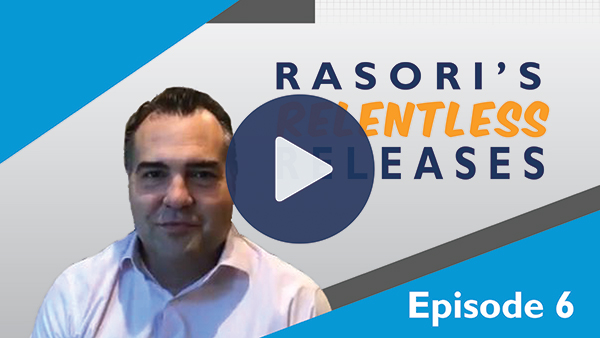
Rasori’s Relentless Releases Episode 6:
Published 2/7/2020
In MCT’s sixth episode of Rasori’s Relentless Releases, Phil Rasori covers the January 14th proposal of volume caps on agency cash window deliveries, the features of the MCTlive! Pool Optimizer and also reviews a new comparison tool.
View the episode to get the scoop on these timely updates.
MCT® is continually optimizing our capital markets software to keep up with the current market space. In an effort to inform you of these real time enhancements this video will review the latest MCTlive! innovations and functionality updates for your benefit. View the episode then join our newsletter to be updated on new releases.
About the Video:
In Episode 6 of Rasori’s Relentless Releases, Phil Rasori discusses the MCTlive! Pool Optimizer, new comparison tools and our approach to the January 14th proposal of volume caps on agency window deliveries.
Topics Include:
- A review of the January 14th proposal of volume caps on agency cash window deliveries and how MCT is helping clients address this change
- Review the MCTlive! Pool Optimizer features and how it can be used to address this new proposal
- Overview of new comparison tools to receive summarized commitment breakdowns even if you’re not an MCT client
Want to stay updated? Join our newsletter to be notified of future releases.

Rasori’s Relentless Releases focuses on technology updates to MCTlive!, MCT’s award-winning loan pipeline management software.
Features include:
- 100% Cloud-Hosted, Web-Based, Real-Time Functionality
- Multidimensional Pull-Through Analytics
- MCT Marketplace loan trading exchange
- Electronic TBA Trading
- Rapid Commit for Agency Delivery
Video Transcript
Hello and welcome to Episode 6 of MCT’s Relentless Releases. Today’s release covers some features of the MCTlive! Pool Optimizer and also reviews a new optimizer comparison tool.
Which we’re really excited about because of its ability to allow non current MCT customers to directly load their data and execution in order to compare our model versus their current solution. Additionally, ever since the January 14th proposal of volume caps on agency cash window deliveries, pool optimization has had some renewed focus. We will have a webinar in the near future that will review all of the potential implications of these caps and also all of our best execution recommendations.
Just to give a couple quick comments on it right now. Our first observation, just to level set, would be just to keep perspective on this. If you just look, at the mountain of executive orders that have been signed, the newly nominated HUD secretary and the already public change in posture at CFPB, no matter where you stand politically on agreeing or disagreeing with any of this. I think it’s safe to say the past recommendations just might not be gospel in the new administration. While only the top echelon of lenders, from a volume perspective, could be affected by the new limits, the majority of correspondent aggregators use some form of cash window commitments for at least a portion of their back end agency execution. And it is this fact where we’re concerned about the potential negative downstream effects to execution that this could have for even the smallest of lenders.
Most importantly though, it is indisputable that the granularity of pricing technologies surrounding the cash windows, have facilitated more transparency into the spec markets which have made it easier for lenders of all sizes to pass these securitization price improvements to the borrower.
And at the end of the day, for those of us in capital markets, that is what we are all here to do.
The good news in the context of this release, is that regardless of whether you are delivering cash window or MBS, constrained optimization is needed. I’ll first review the background for the need of optimization.
The genesis of the need for the current construct of agency optimization dates back to July 2008 when the Housing and Economic Recovery Act was passed, which permanently established high balance loan limits for the GSEs. Two weeks later the Securities Industry and Financial Markets Association or SIFMA announced that High Balance loans would be eligible for TBA trades but that they limited to up to 10 percent of the total balance of a TBA pool.
Mortgage backed security pools with high balance concentrations greater than the 10 percent de minimis limit would become jumbo conforming or super conforming pools and therefore trade at a discount to the standard TBA pool.
From a best execution perspective, this 10 percent de minimis rule created the need to drive as many conforming loans as possible into a given agency pool or commitment. Using an example, if a given best ex results in a potential 5 million dollar conforming 30 year commitment and we have a 600000 dollar high balance loan, we aren’t able to add this loan to the given commitment and still have a conforming TBA eligible pool since the 600000 dollar high bal would make up over 10 percent of the 5.6 million dollar commitment. In this example, we would need to add at least 400000 in conforming volume to achieve a total commitment of at least 6 million which would allow the 600000 dollar high balance loan to get conforming pricing.
The need for optimization comes when we need to sacrifice the best execution of the given 400000 dollar conforming loan when moving and adding it to the conforming 5 million dollar commitment.
And its exactly at this point where capital markets participants begin to oversimplify the problem. At first glance, in an optimally allocated commitment where the full 10 percent limit is used, you can see that there is a ratio of 9 to 1 conforming to high bal volume. As a result, a lot of people make the initial mistake of assuming that the improvement in execution that results from driving the high bal into a conforming commitment must be at least 9 times the execution sacrificed by the conforming loan. Or said another way, on a volume equivalent basis the sacrificed pickup must be less than one ninth, or about 11 percent, of the high balance to conforming pickup.
However, this is simply not correct because it doesn’t incorporate the volume ratio of sacrificed to enhanced executions. In our example of assigning an inferior execution to a 400000 dollar conforming loan, in order to allow the 600000 high bal to enter the conforming pool, we would be willing sacrifice up to 150 percent of the high bal to conforming pickup after adjusting for volume. What complicates this simple weighted average calculation is the fact that in any given best execution analysis there are thousands, if not millions, of possible loan execution combinations.
And calculating this combination of loans that achieve the highest weighted average price for the global population is the initial basic need for optimization.
On the securitization side, in addition to the coupon decisioning parameter, there are minimum spec volume thresholds that insert further complexity and computational intensity into the algorithm.
As a point of reference for scale, for a cross agency optimization consisting of twenty five hundred loans including high balance and seven volume constrained spec populations, our model will run over 90 million iterations. And the calculations get significantly more intense as you layer in additional executions, such as optimizing across multiple servicer cash commitments within an agency.
And before we move to the comparison tool, I just want to make a couple comments on technology and the affect it has on the actual optimization results. The current construct of our AWS server cluster that is tasked to this optimization project uses parallel computing frameworks that allow us to run these optimizations across multiple clients simultaneously.
The Bottom line is that these high performance and cpu intensive tasks are simply not possible with a legacy on prem server. In order to achieve a true globally optimal result, the iterations must be run. There are simply no shortcuts to a global solution.
And it’s for this reason that we are so confident that the MCTlive! Pool and Commitment Optimizer sets a new standard for our industry. In order to facilitate transparency of our model’s performance versus our competition, we’ve created a comparison tool that will allow non-MCT customers to easily run our algorithm against their current provider.
The beauty of this competitive performance analysis is that you can run it independently of MCT. We don’t need to know your current model provider or even your current best executable commitment or pool solution. For cash window sellers you will simply load your loan populations and the associated possible executions for each loan. For those of you securitizing you’ll load your coupon executions and this tool also allows you to customize your minimum spec volume thresholds. From there you can run the algorithm on your own, view summarized results and export the optimized coupon or commitment breakdown.
We look forward to the positive effects on secondary execution that these new technologies will have on our current and future customers as well as the industry as a whole. As always, thank you for your time and I look forward to seeing you on our next Relentless Releases video.

“While only the top echelon of lenders, from a volume perspective, could be affected by the new limits, the majority of correspondent aggregators use some form of cash window commitments for at least a portion of their back end agency execution.”
Phil Rasori, COO, MCT
About the Host:
Phil Rasori, Chief Operating Officer, MCT
Mr. Rasori is a recognized thought-leader in capital markets operations within the mortgage banking community. His areas of expertise include complex financial modeling, computational dynamics, and linear programming for operational optimization. He developed the ground-breaking mortgage pipeline hedging algorithms that form the foundation of MCT’s HALO Program today. He has also pioneered several metrics that have become standard industry parlance, including “beta pull-through” factors. In addition to banking clients, Mr. Rasori has consulted with GSE agencies and the US Government on hedging best practices for community banks. Mr. Rasori has functionally led MCT operations since 2005 and ascended to his current role as COO in 2007.
Mr. Rasori is a graduate of University of California, San Diego, and holds a B.S. in Management Science.




